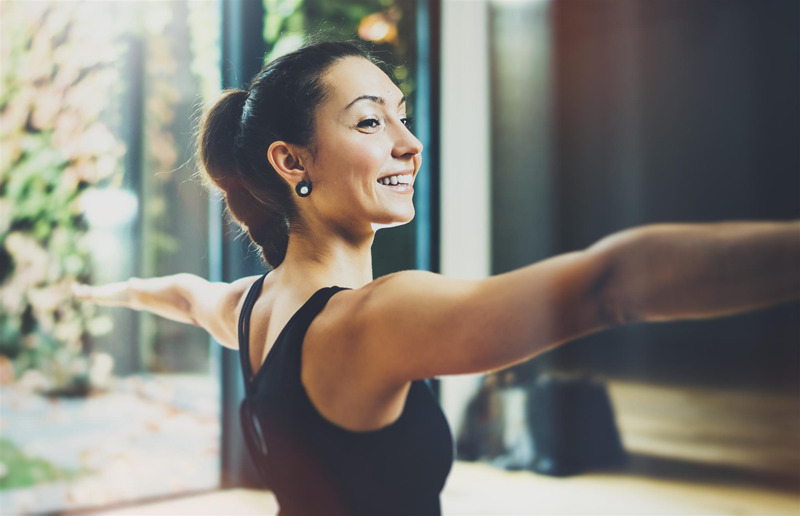Most of us know that exercise can make us happy, particularly when practiced regularly. However, many of us assume that the exercise must be high-intensity to have an effect. Fortunately, this is far from the truth. Sometimes, low-intensity exercise such as yoga is more beneficial than pushing ourselves to the limit. Better still, all you need to get started is a yoga top and some breathable shorts. In this article, we explore how yoga makes you happy.
Decreases Cortisol
While intense exercise has its benefits, it can often increase our cortisol levels. Known as the ‘stress hormone’ heightened cortisol levels can leave us feeling tense and on-edge. Thankfully, yoga has the opposite effect. Lowering cortisol levels, yoga benefits the parasympathetic nervous system. Explained simply, this means that regular practice can reduce the effects of the ‘fight or flight’ response that sets in when we are feeling stressed or anxious. Helping us to remain cool, calm, and collected, the reduction in cortisol can make us feel happy.
Additionally, the practice can reduce stress by promoting mindfulness. Designed to keep you in the present, meditation can be used to increase happiness. Meditating for just 5 minutes each day can lower your heart rate and blood pressure, allowing you to take on the day feeling relaxed and rejuvenated.
Increases Serotonin
If our serotonin levels drop too low, we are at risk of suffering from depression and general unhappiness. Thankfully, research suggests that yoga can be used to naturally increase our serotonin and benefit our emotional health. Additionally, the practice releases endorphins into the body. Known as ‘happy hormones’, endorphins are released when we partake in physical exercise. Providing that we immerse ourselves in the activity, even low-intensity asana practice will release endorphins and leave us feeling happy and stress-free.
Makes New Friends
It’s no secret that our social life can affect our mood. If we surround ourselves with negative people, it can start to have an effect on our mental health. Through yoga, we can meet likeminded individuals with similar goals. As well as bonding with these people as fellow classmates, many people choose to meet up outside of the sessions, too. Although not everybody in the class will have the same goals, most people are there to better themselves in some way. This means that you can encourage each other to improve and stay committed to the journey.
Increases Blood Flow
While blood flow and happiness aren’t directly related, improving your blood flow can lead to better physical and emotional health. As circulation is improved, oxygen is delivered efficiently to the major organs. Providing each area of the body with fresh, oxygenated blood, increased blood flow can reduce fatigue and muscle discomfort. When we are feeling healthy, we naturally feel much happier than we do if we’re feeling unwell.
Increases Gamma-Aminobutyric Levels
With many forms of exercise, it can take months to notice the benefits. With yoga, however, you should notice results immediately. Studies suggest that a single session can boost the brain’s Gamma-Aminobutyric levels (GABA). Associated with general happiness, an increase in GABA levels means you can start to feel happy after just one class!
Yoga Poses to Increase Happiness
High Lunge Twist
Detoxifying the body and mind, twists are ideal for those looking to become happier. Allowing you to rid the body of what it doesn’t need, High Lunge Twist can be used to create new space in both the body and mind.
To practice the asana, stand tall on your mat. Step forward with your right foot and bend your right knee while keeping your left leg straight. Next, bring your hands together in a prayer position at the center of your chest. Take a deep breath in and lift your chest towards the ceiling. As you exhale, draw your navel toward your spine and twist your torso to the right. Finally, hook your left elbow on the outside of your right thigh. You are in High Lunge Twist. Hold the position for around 30 seconds then repeat on the other side.
Bridge Pose
A type of restorative asana, Bridge Pose can increase happiness by revitalizing the body and mind. Additionally, the posture can be used to increase blood flow and oxygenate the organs. To practice the asana, lie on your back with your knees bent. At this stage, the soles of your feet should be touching the mat. Next, relax your arms by your sides and tuck your chin into your chest. Finally, lift your back and buttocks off the ground to create a bridge. You are in Bridge Pose. Hold the position for around 5 breathes before lowering yourself back down to the mat.
Camel Pose
Designed to open the chest, Camel Pose can drastically increase your lung capacity. Over time, this can allow for deeper breathing and help you to feel happier and healthier.
To practice the asana, begin in a kneeling position with your hips directly above your knees. Your weight should be supported by your shins and the tops of your feet. Next, reach your arms back and place your hands on the backs of your thighs. Bring your shoulder blades and elbows together so they’re not winging out. Finally, look at the ceiling and lift your chest upward before moving your hands to your heels. You are in Camel Pose. Hold the posture for at least 5 breathes before releasing the backbend. To increase the stretch, continue to arch the back throughout the asana.
In Summary
When practiced regularly, yoga can help to make us happier. If you’re interested in reaping the benefits of the practice, pick up some yoga pants and begin with the postures above.

